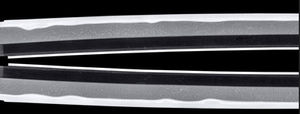Create Your First Project
Start adding your projects to your portfolio. Click on "Manage Projects" to get started
Japanese Katana Kanetsune Muromachi Period Eisho 1504
KANETSUNE KATANA - NBTHK Hozon Certificate
** CLICK IMAGES TO SEE LARGER **
Unsigned: Muromachi Period 永正Eisho Era 1504 AD Kotō Blade
Signature: Mumei (Kanetsune - attribution by NBTHK)
NBTHK HOZON CERTIFICATE # 302386
The NBTHK Certificate was issued in Showa 59 (1977). At this time Oshigata was used on the certificates.
NBTHK stopped using Oshigata in mid Showa 62 (1987), after that, with modern technology they used photos.
A sword designated as Worthy of Conservation by the Society for the Preservation of the Japan Art Sword.
This is no small task to achieve. It is not uncommon for a sword dealer to submit ten swords for judgement and only receive two HOZON swords
In the "Kaihō-kenshaku": Kanetsune blades are ranked as Wazamono. "sharp swords"
Fujishiro Ranking : Jo Jo Saku (superior –superior made = Highly Superior)
Blade is polished
Nagasa (Length) : 69.7cm
Sori (Curvature) : 1.2 cm
Mekugi: 2
Width at hamachi : 3.06 cm
Width at kissaki : 2.35 cm
Kasane : 0.63 cm
Jigane: Itame Hada well grained with Jinie attach.
There are Chikei. visible to see the texture
Hamon: Nie Deki, Suguha. Some parts are Gunome Midare.
There are Ko-Ashi. Boshi is Midarekomi Jizo-Fu
Koshirae:
Tsuba: Naga Maru gata – iron . Pattern in openwork
Signed: Shoami Shigenobu
Fuchi: Shakudo with Kamon. Maruni Tosa Kashiwa – Yamanouchi Lord of Tosa
This mon was later adopted by Mitsubishi
Kashira : Black Horn
Menuki: Branching Leafage black
Saya: Black Ishime-Ji
Shirasaya:
A$11,000
It is said that the first generation Kanetsune (初代兼常) belonged to the Yamato school in Nara prefecture. Moved to Mino province in O-Ei era 応永 (1394-1428 early Muromachi Period).
Since then, the school flourished for many generations. The school’s fame was close to that of Magoroku Kanemoto, Izumino kami Kanesada, Hachiya Kanesada, Kanenori , all well known prestigious sword smiths in Mino province with Kanetsune.
Especially Kanetsune who moved to Owari province, he was called Owari Sagami Kami Kanetsune and was the top ranking sword maker.
The Kanetsune blades are well known as cut well swords with nice jigane.
Eisho 1504 was the height of prosperity for the Kanetsune family.
Many swords were produced at this time.
Mino -Den prospered during the Sengoku Jidai (Warring State period) due to the high demand for weapons, and the location of Mino province was ideally situated. Akechi Mitsuhide controlled Mino province, Nobunaga Oda ruled Owari province, Tokugawa Ieyasu was the lord of Suruga (Neighboring areas).
There was high demand from those powerful feudal lords and their retainers as many wars occurred between the Kanto region and the Kyoto area. Mino is located in the middle, making it convenient for feudal lords to order swords from Mino-Den.
The blades forged in Mino province had the reputation for their practical design and sharpness.
Many feudal lords demanded swords forged in the Mino province.
This superb sword was first registered in Showa 40 (1965) 6th Month 17th day, An indication that was in the possession of the former owners for a very long time.
The NBTHK Hozon certificate issued in 1977.
The NBTHK (Nihon Bijutsu Token Hozon Kyokai), the Society for the Preservation of the Japan Art Sword, was founded in 1948, and remains a highly trusted organization responsible for screening and certifying judgement onto Japanese swords. When a sword is submitted to the NBTHK (known as “shinsa” or judging), the organisation reviews and then places a judgement on the piece in question.































